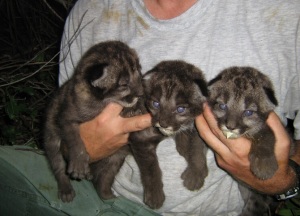Young panthers rescued, returned to pen in Yulee
For immediate release: November 1, 2012
Contact: Karen Parker, 386-758-0525
Young panthers rescued, returned to pen in Yulee
The two escaped panthers were returned to their pen today following their capture by experts from the Florida Fish and Wildlife Conservation Commission (FWC), White Oak Conservation Center and houndsmen from Ranchers Supply, Inc.
The two cats, outfitted with radio collars, had been monitored continuously after winds from Hurricane Sandy knocked down a tree onto their enclosure fence, where the two panthers, a female and her brother, were being raised at White Oak Conservation Center.
The panther experts used telemetry to track the radio-collars on the cats. The animals did not stray far from their pen, according to officials, and remained on White Oak property during the brief stint outside their pen.
“We are happy to report that the two are back safe and sound,” said Kipp Frohlich, head of the Imperiled Species Management Section at the FWC. “The cats were pursued by panther dogs, darted and moved back into their enclosure.”
They were both examined by veterinarians and found healthy.
The two cats were initially captured when they were 5 months old. They were found near the Corkscrew Regional Ecosystem Watershed in northern Collier County in September 2011.
“The two kittens, born in May 2011, were trapped by our staff due to the death of their mother,” said Frohlich. “They were transferred to White Oak Conservation Center to be raised and prepared for release later this winter back to south Florida, where they were originally rescued, to help continue our panther recovery efforts.”
The pens are very secluded, and the panthers can be raised with very little contact with people. Five other kittens, three females and two males of similar ages, have been raised at White Oak and released in south Florida.
The FWC has a contract with White Oak to care for panther kittens.
“They are uniquely qualified to raise panthers in an environment that maximizes their chances for a successful re-introduction back into the wild,” said Frohlich.
Scientists estimate that between 100 and 160 adults and subadults remain in south Florida.

